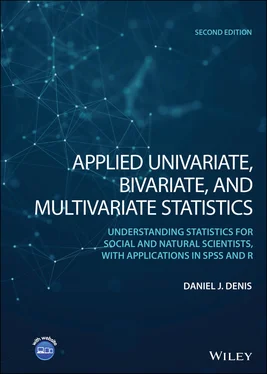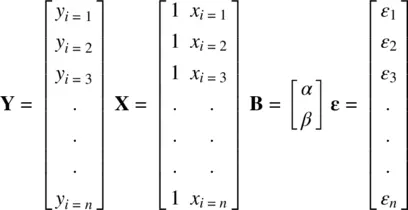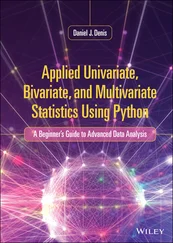Daniel J. Denis - Applied Univariate, Bivariate, and Multivariate Statistics
Здесь есть возможность читать онлайн «Daniel J. Denis - Applied Univariate, Bivariate, and Multivariate Statistics» — ознакомительный отрывок электронной книги совершенно бесплатно, а после прочтения отрывка купить полную версию. В некоторых случаях можно слушать аудио, скачать через торрент в формате fb2 и присутствует краткое содержание. Жанр: unrecognised, на английском языке. Описание произведения, (предисловие) а так же отзывы посетителей доступны на портале библиотеки ЛибКат.
- Название:Applied Univariate, Bivariate, and Multivariate Statistics
- Автор:
- Жанр:
- Год:неизвестен
- ISBN:нет данных
- Рейтинг книги:5 / 5. Голосов: 1
-
Избранное:Добавить в избранное
- Отзывы:
-
Ваша оценка:
Applied Univariate, Bivariate, and Multivariate Statistics: краткое содержание, описание и аннотация
Предлагаем к чтению аннотацию, описание, краткое содержание или предисловие (зависит от того, что написал сам автор книги «Applied Univariate, Bivariate, and Multivariate Statistics»). Если вы не нашли необходимую информацию о книге — напишите в комментариях, мы постараемся отыскать её.
contains an accessible introduction to statistical modeling techniques commonly used in the social and behavioral sciences. The text offers a blend of statistical theory and methodology and reviews both the technical and theoretical aspects of good data analysis.
Featuring applied resources at various levels, the book includes statistical techniques using software packages such as R and SPSS®. To promote a more in-depth interpretation of statistical techniques across the sciences, the book surveys some of the technical arguments underlying formulas and equations. The thoroughly updated edition includes new chapters on nonparametric statistics and multidimensional scaling, and expanded coverage of time series models. The second edition has been designed to be more approachable by minimizing theoretical or technical jargon and maximizing conceptual understanding with easy-to-apply software examples. This important text:
Offers demonstrations of statistical techniques using software packages such as R and SPSS® Contains examples of hypothetical and real data with statistical analyses Provides historical and philosophical insights into many of the techniques used in modern social science Includes a companion website that includes further instructional details, additional data sets, solutions to selected exercises, and multiple programming options Written for students of social and applied sciences,
offers a text to statistical modeling techniques used in social and behavioral sciences.







 :
:
 is the maximum correlationbetween linear combinations on the same variables, it is called the canonical correlation, discussed in Chapter 12. The correlation between linear combinations plays a central role in multivariate analysis. Substantively, and geometrically, linear combinations can be interpreted as “projections” of one or more variables onto new dimensions. For instance, in simple linear regression, the fitting of a least‐squares line is such a projection. It is the projection of points such that it guarantees that the sum of squared deviations from the given projected line or “surface” (in the case of higher dimensions) is kept to a minimum.
is the maximum correlationbetween linear combinations on the same variables, it is called the canonical correlation, discussed in Chapter 12. The correlation between linear combinations plays a central role in multivariate analysis. Substantively, and geometrically, linear combinations can be interpreted as “projections” of one or more variables onto new dimensions. For instance, in simple linear regression, the fitting of a least‐squares line is such a projection. It is the projection of points such that it guarantees that the sum of squared deviations from the given projected line or “surface” (in the case of higher dimensions) is kept to a minimum.












